In the world of organic SEO and paid search marketing, pet insurance is a fiercely competitive industry.
Pawp, which promotes itself as “The digital health clinic for your pet,” was one of the first startups I came across. Not only had Pawp recently raised $13 million, but the company’s founder, Marc Atiyeh, tweeted a short while ago that they had decided to focus on organic SEO growth (which I think is a wonderful approach) and that they now rank first on Google for “emergency pet insurance.”

While many businesses jump right into “paid SEM” spending large sums of money to try and gain some type of customer acquisition ROI through ad spend, I am a firm believer in organic SEO and content as a growth strategy for scrappy startups.
With that in mind, here are some suggestions I have for Pawp as they strive to improve their search rankings and online presence in the pet insurance industry.
(Assumptions and notes: I’m going to surmise that Pawp has made a list of keywords and long-tail phrases for which they want to rank. As a result, rather than suggesting keywords or conducting a thorough audit, I will offer some friendly suggestions as to where I believe they can improve.)
On-Page SEO for Pawp Pet Insurance
On the plus side, it appears that Pawp has put a lot of effort and thought into their on-page SEO strategy. However, I like to think of organic search rankings as an Olympic athlete attempting to outperform their competitors.
In this scenario we are seeking to gain the smallest .1% of an advantage over our competition via focused preparation and persistent dedication. The emphasis is on the tiniest of subtleties and the smallest of details required to succeed by the slimmest of margins. As a result, seemingly minor changes may have long-term consequences, both positive and negative.
1. Title Tag (Meta Title)
When it comes to organic SEO and search algorithms, title tags are believed to be a very strong signal in terms of how your site is viewed by search engines. More specifically, according to Moz, “The title tag of a web page is designed to provide an accurate and concise description of a page’s content.”
Pawp’s title tag is structured as follows: “Pawp | The Digital Health Clinic For Your Pet.” (See image below.)

Following present-day naming conventions and SEO best practices, the title is currently 396 pixels long, which falls comfortably within the maximum recommended length of 600 pixels.
However, a couple of suggestions I have are to replace the word “digital” with “online” and to add the term “pet insurance.” According to Google’s Keyword tool, “digital health clinic pet” is searched 0-10 times per month, as shown below. Note: not a huge number of queries.

If the Pawp team wanted to experiment with a phrase that still accurately describes their pet insurance and vet care solution, I would suggest something similar to the following: Pawp | Online Vet Care and Pet Insurance. If you are wondering, the newly suggested title is 375 pixels long.
Furthermore, as shown in the graphic below, the suggested title dramatically boosts potential search volume from 0-10 searches per month up to 100-1000 monthly searches. The title now also contains the term “pet insurance” and provides a very succinct summary of what Pawp does and how they may address an end user’s problem.
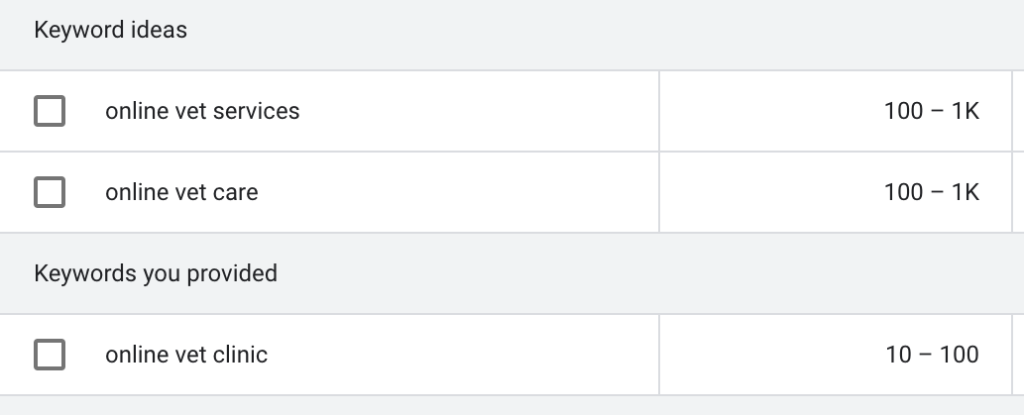
2. Meta Description
In search results, meta descriptions are the small paragraphs of text that appear beneath the title tag. According to SEO thought leading website, Moz, “The meta description provides a brief summary of a web page. Search engines such as Google often display the meta description in search results, which can influence click-through rates.”
According to most SEO experts, meta descriptions are not a significant “signal” to Goole in terms of rankings, but they do provide the end user a better idea of what your website will be about. (Sidebar: Poorly crafted meta descriptions that exceed the recommended length of 160 characters (920 pixels) in length are a pet peeve of mine!)
In terms of pet insurance SEO, the following is a screenshot of Pawp’s meta description as it appears in Google’s search results.

Typically, the “…” indicates that a website’s description is longer than the recommended length and has been cut off. However, because Pawp’s description is only 660 pixels long, further investigation is required to determine the “cut off” issue.
I would suggest that Pawp rework their text to a more specific, concise, and descriptive version within the confines of the space that Google is currently providing. For example, a description similar to the following might prove more beneficial, “Pawp offers online veterinarian care and pet insurance because sometimes emergency vet visits are unavoidable.”

Additionally, if Google decides to give Pawp a bit more pixel length in the future, I would also add “Trusted by pet parents and vets nationwide” to the description.
3. Page Speed (Critical!)
While the first two on-page SEO items I mentioned are open to debate and healthy discussion, the third issue I’m going to discuss, page speed, is critical and must be addressed immediately.
Google’s Core Web Vitals, which began rolling out in August 2021, “represent a distinct facet of the user experience, is measurable in the field, and reflects the real-world experience of a critical user-centric outcome. The current metrics focus on three aspects of the user experience—loading, interactivity, and visual stability.”
Pawp’s desktop website, as shown in the screenshot below, has some issues with “loading,” or as the metric is more popularly known, “page speed.” According to PageSpeed Insights the desktop version ranks at 62 out of a possible 100 total points. The biggest issue appears to be the “Largest Contentful Paint” (LCP) metric which marks the time that the largest text or image is painted.
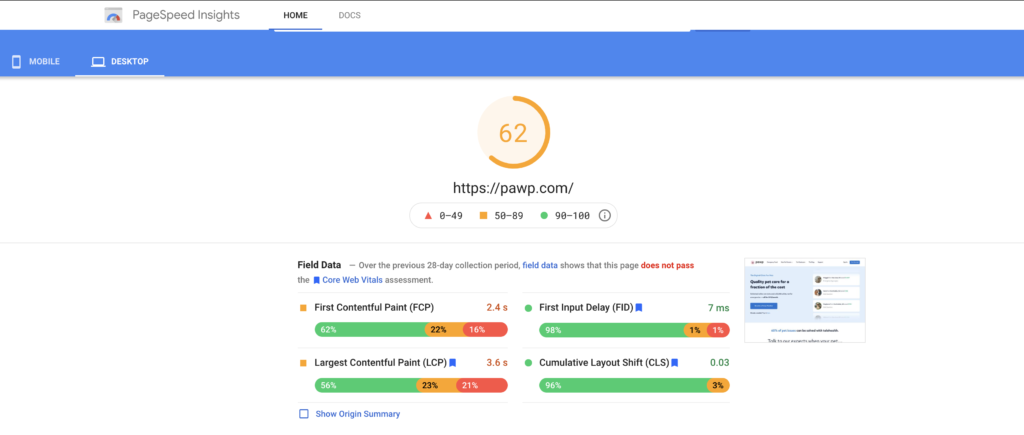
- Properly size images 0.38 s
- Eliminate render-blocking resources 0.32 s
- Reduce unused JavaScript 0.28 s
While the desktop has some issues, it’s the mobile site speed that is going to have a detrimental effect on user experience and ultimately organic “pet insurance” search rankings!
When you examine Pawp’s mobile benchmarks using page speed, they are at a lackluster 22 out of 100 and that places them squarely in the “poor” category. Specifically, 23% of loads for the mobile page have a poor (> 3 seconds) “First Contentful Paint” (FCP) and 46% of page loads have a poor (> 4 s) “Largest Contentful Paint” (LCP) with an average of 5.7 seconds.
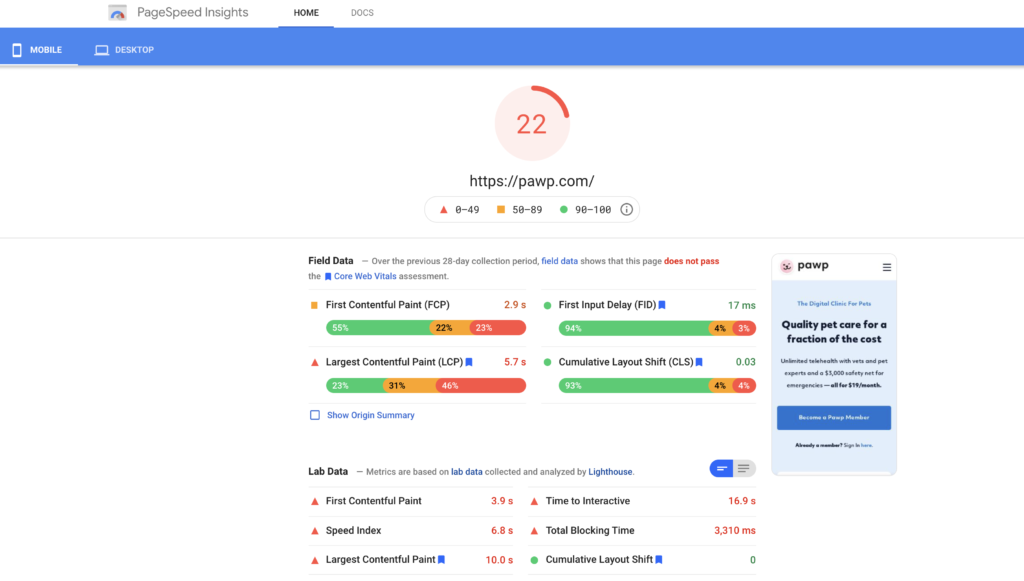
I’m not a coder, but based on the findings, Pawp’s technical team should seriously consider reducing unused JavaScript and removing render-blocking resources at their earliest convenience.
Organic Content Ideas for Pawp Pet Insurance
As previously stated, ranking in Google for search terms related to the pet industry and pet insurance is extremely difficult. The beauty is that many people frequently overlook a content strategy that seeks to fill in the “gaps” between extremely difficult to rank for shorter keyword subjects and the slightly easier and tangentially similar long-tail phrases that can provide ranking opportunities.
The Pawp blog contains a fair amount of helpful articles that are essential for developing a content strategy and organic SEO approach for the online vet visit and pet insurance space. However, there are a couple of areas where I think Pawp could improve their foundational scheme and provide exceptionally useful content to their existing and potential customers.
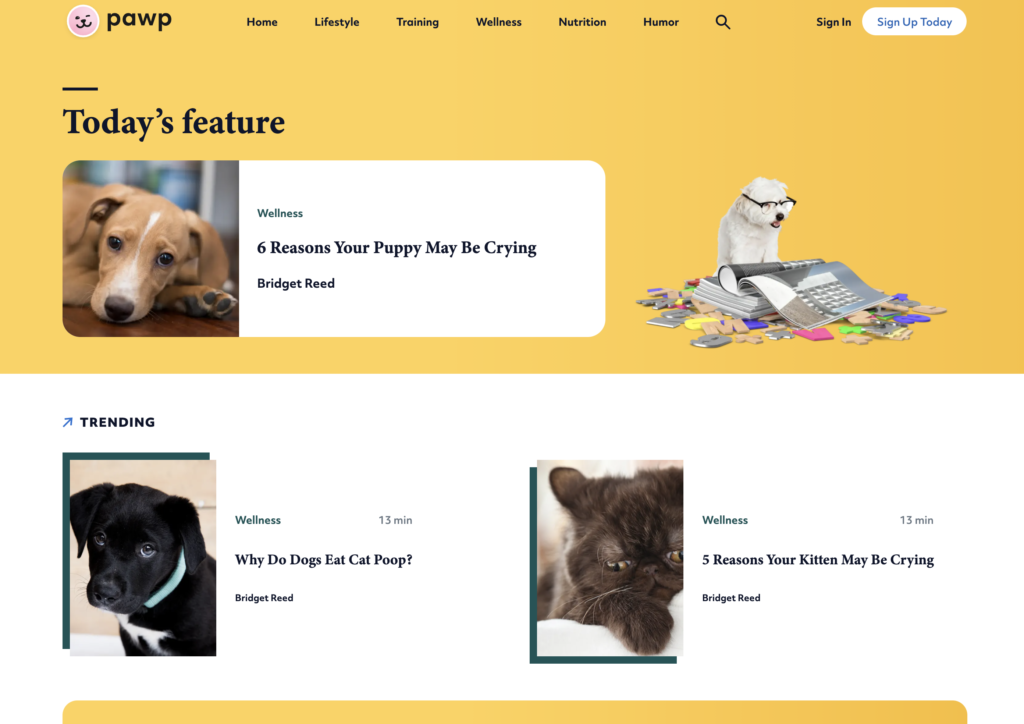
1. Radically Helpful Content (Sometimes called Cornerstone Content)
Google’s primary objective is to guide people in solving issues by returning the most relevant and accurate search results available. To that end, what I like to refer to as “radically helpful content” (also known as “cornerstone content“) can help to bridge the gaps in search rankings outlined above.
What exactly is radically useful content? Simply stated, this is a piece of content where the focus is on delivering the most comprehensive and significant information about a specific subject. The objective here is to create undeniable, enormous value that is so good that readers feel driven to share and link back to it.
Often times, cornerstone content is delivered as an “Ultimate Guide,” a “Definitive Guide,” or even a comprehensive “How To” type article. These are also typically fantastic resources for gathering email addresses and expanding your contact list.
Regarding Pawp, here are five post ideas that they could utilize right away to start filling their “radically helpful” content category:
Post Idea 1: Virtual Vet Visit: The Ultimate Guide to Maximising Your Consultation – Average monthly searches 1k – 10k and low competition.
Post Idea 2: Nationwide Pet Insurance vs Pawp Pet Insurance: The Definitive Breakdown – Where it would be almost impossible to rank for “pet insurance,” Nationwide has an average monthly search volume of 100k – 1 million. Most importantly, the term “nationwide pet insurance” has a low “competitive value” of 12.53 according to Wordtracker.
Post Idea 3: Most Epic Dog Walks In The USA – While only tangentially aligned with pet insurance and vet visits, we can assume that these pet parents will eventually require Pawp’s services. The content would attempt to gain rankings traction for the term “dog walks” which is searched up to 100k times a month and has a Wordtracker competition score of 14.57. Note: this could also be broken down as unique blog posts by individual cities to get even more granular at the local level and then the posts could be collated into the larger “Most Epic Dog Walks” in the USA.
Post Idea 4: Dog Photoshoot: The Professionals Guide to Photographing Your Pup – Similar to above, the goal is to draw in pet parents by providing them a comprehensive resource for their beloved pet. More importantly, the term “dog photoshoot” is searched for 1k – 10k times per month, and even better, according to Wordtracker, it has a competition score of 6.23 with only eight web pages having the keyword in a title tag.
Post Idea 5: Veterinarian Near Me: Your Indispensable Guide to Vets In XXXX City – Admittedly, the title is a bit clunky and grammatically incorrect! But, with a bit more tweaking the term “veterinarian near me” is what I would consider a unicorn when it comes to filling a needed content gap.
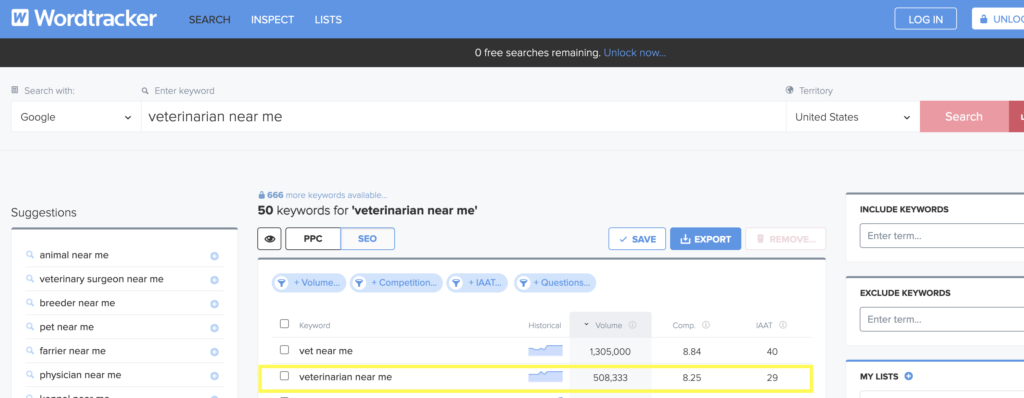
As you can see in the screenshot above, the phrase is searched over 500,000 times each month, with a competition score of 8.25 and a fairly low IAAT score! If Pawp wished to experiment with paid search marketing, Google has the bidding for this phrase set to “low” for top of results page placement.
To sum up, this post is intended to provide Pawp with some constructive feedback on their organic SEO strategy and content offerings. This article has gone on for a little longer than most people are willing to read. However, I have a slew of fresh ideas for Pawp’s reputation management strategy and YouTube channel that I haven’t even touched on. Surprisingly, Pawp’s YouTube channel hasn’t had any new content published in almost a year. This is a huge missed opportunity for them as YouTube is the second most searched website on the internet.
Always remember, when it comes to content creation and organic SEO there are no secret tricks or shortcuts. The only path to success is a dedication to creating new content and maintaining consistency over time.
